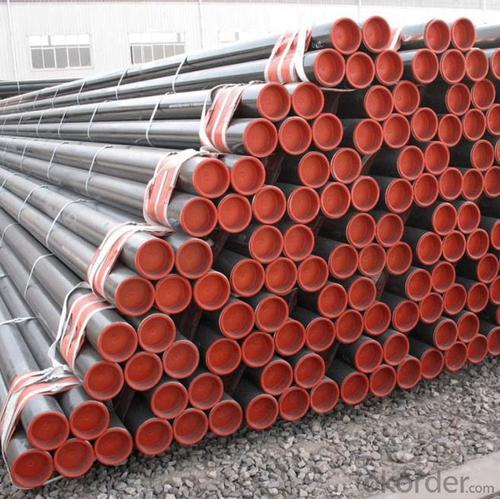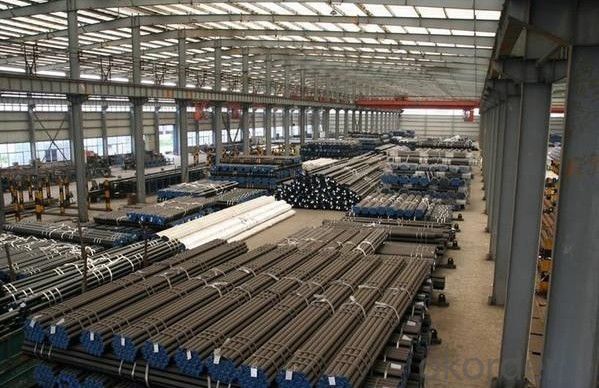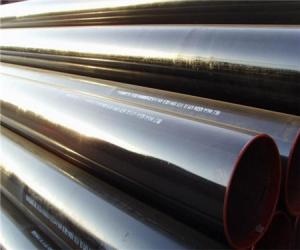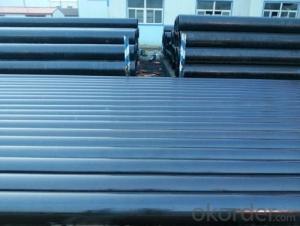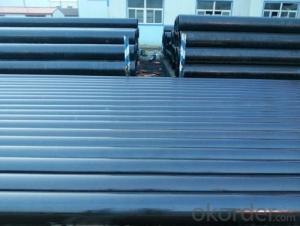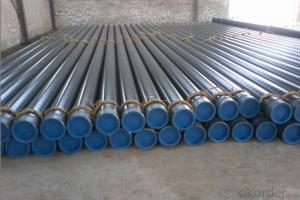Seamless tube ASTM A53/ASTM A 106/API 5L grade B
- Loading Port:
- Tianjin
- Payment Terms:
- TT OR LC
- Min Order Qty:
- 10 m.t.
- Supply Capability:
- 5000 m.t./month
OKorder Service Pledge
OKorder Financial Service
You Might Also Like
1. Commodity Name: Seamless steel pipe
2. Standard: API,GB,ASTM,ASME,DIN
3. Quality grade: 10#, 20#, A106B, A53B, API 5L B, Q235, Q345, ST37-2, ST 45, ST52.etc.
4. Dimension:
OD: 1/2"-24"
WT: 2.5-80mm, SCH10~SCH40~XXL
length: 5.8m,6m,8m,9m,12m
5. Technique: Hot Rolled/Cold Rolled/ Cold Drawn
6. application
carbon seamless steel pipes are widely used in gas, water and oil, transpotation;constructions;Bridge,highway,windows of model steel door; building materials;fences;heating facilities Fluid Pipe;conduit pipe,scaffolding pipe.etc.
7. Payment Terms: L/C D/A D/P T/T
8.packing and shipment
Packaged in bundles,as per customers' requirements, it can also bepackagesd as beveled ends, typed marking, black painting, plastic caps protection,woven bags packing
For 20" container the max length is 5.8m; For 40" container the max length is 12m. other options are available based on customer requests. Please discuss when placing orders.
9. Surface: painted with varnish;
10. Plastic caps at ends.
11. Tolerance: OD +1%/-1%
WT +12.5%/-10%
12. Chemical composition:
Models of Steel Pipes | Chemical Component | |||||||
Steel 20 (ASTM A106B) | C | Si | Mn | P | S | Cu | Ni | Cr |
0.17~0.24 | 0.17~0.37 | 0.35~0.65 | 0.035max | 0.035max | 0.25max | 0.25max | 0.25max | |
Steel45 (ASTM 1045) | 0.42~0.50 | 0.17~0.37 | 0.50~0.80 | 0.035max | 0.035max | 0.25max | 0.25max | 0.25max |
16Mn(Q345B) | 0.12~0.20 | 0.20~0.55 | 1.20~1.60 | 0.035max | 0.035max | 0.25max | 0.25max | 0.25max |
45Mn2 ( ASTM1345) | 0.42~0.49 | 0.17~0.37 | 1.40~1.80 | 0.035max | 0.035max | 0.3max | 0.3max | 0.30max |
- Q: Can steel pipes be used for architectural purposes?
- Yes, steel pipes can be used for architectural purposes. Steel pipes are often used in construction projects for structural support, such as in the construction of buildings, bridges, and stadiums. They are also commonly used for architectural design elements, such as handrails, staircases, and decorative features. The durability, strength, and versatility of steel pipes make them a popular choice in architectural applications.
- Q: How do you transport steel pipes safely?
- In order to transport steel pipes safely, it is essential to engage in proper planning, utilize appropriate equipment, and adhere to safety measures. To ensure the safe transportation of steel pipes, the following guidelines should be followed: 1. Select suitable transportation equipment: Opt for either a flatbed trailer or a truck with a flatbed when transporting steel pipes. Make certain that the trailer or truck is equipped with a robust and secure tie-down system to prevent any movement or shifting of the pipes during transit. 2. Secure the pipes: Use either nylon or steel straps to fasten the steel pipes to the trailer or truck bed. Ensure that the straps are adequately tightened so as to evenly distribute the weight of the pipes and prevent any potential movement or shifting. 3. Safeguard the pipes: Implement the use of pipe chocks or protective materials such as foam or rubber to prevent the steel pipes from rolling or rubbing against each other during transportation. This will aid in minimizing any possible damage and maintaining the integrity of the pipes. 4. Adhere to weight restrictions: Verify that the weight of the steel pipes being transported does not exceed the load capacity of the transportation equipment. Overloading can lead to instability and compromise safety. 5. Comply with road safety regulations: Abide by all local traffic laws and regulations, including adhering to speed limits and securing any necessary permits or licenses for oversized loads if required. Additionally, utilize hazard warning signs or flags when transporting lengthy or oversized steel pipes to alert other road users. 6. Perform regular inspections: Prior to embarking on the journey, inspect the straps, tie-downs, and other securing mechanisms to ensure they are in satisfactory condition. Regularly monitor the load during transit to guarantee its continuous security. 7. Plan the route: Select a route that is suitable for the size and weight of the steel pipes being transported. Avoid roads with low bridges, narrow lanes, or weight restrictions that may pose a hazard to the safe transportation of the pipes. 8. Consider weather conditions: Take into account weather conditions, such as strong winds or heavy rain, which can impact the stability of the load. Make necessary adjustments to the transport plan or postpone the journey if deemed necessary. 9. Train and educate drivers: Ensure that the drivers responsible for transporting steel pipes are adequately trained and knowledgeable about the proper procedures for securely and safely transporting the load. Regularly provide them with updates on safety protocols and any changes in regulations. By adhering to these guidelines, the transportation of steel pipes can be executed safely, thereby reducing the risk of accidents, damage to the pipes, and ensuring the safety of all individuals involved in the transportation process.
- Q: How do you select the right size of steel pipe for a project?
- To select the right size of steel pipe for a project, it is important to consider factors such as the desired flow rate, pressure requirements, fluid type, and the overall structural design. Consulting relevant design codes and standards, performing calculations based on these parameters, and seeking expert advice can help ensure the appropriate size is chosen to meet the project's specific needs.
- Q: What is the difference between steel pipes and PEX pipes?
- The main difference between steel pipes and PEX pipes lies in their material composition. Steel pipes are made of rigid metal and are typically used for industrial applications, while PEX pipes are made of flexible plastic and are commonly used for residential plumbing systems. Steel pipes offer durability and strength, but can be prone to corrosion. PEX pipes, on the other hand, are corrosion-resistant and easier to install due to their flexibility. Additionally, PEX pipes have better insulation properties and are less likely to burst in freezing temperatures compared to steel pipes.
- Q: Can steel pipes be used for oil well casing?
- Yes, steel pipes can be used for oil well casing. Steel is a commonly used material for oil well casing due to its strength, durability, and resistance to corrosion.
- Q: Are steel pipes suitable for transporting gas?
- Yes, steel pipes are suitable for transporting gas. They have high strength and durability, making them capable of withstanding the pressure and stress involved in gas transportation. Additionally, steel pipes have excellent resistance to corrosion, ensuring the safety and integrity of the gas being transported.
- Q: What are the common methods for inspecting the condition of steel pipes?
- Steel pipes can be inspected using a variety of methods to ensure their condition and integrity. These methods aim to identify any issues or defects that could potentially affect the pipes. 1. Visual Inspection: Inspectors thoroughly examine the pipes visually to spot any visible signs of damage such as corrosion, cracks, or leaks. They may employ tools like flashlights, mirrors, or borescopes to reach difficult areas. 2. Ultrasonic Testing: This method utilizes high-frequency sound waves to detect defects within the steel pipes. A transducer emits sound waves, and disruptions or reflections in these waves can indicate potential issues like cracks or thinning of the pipe walls. 3. Magnetic Particle Testing: Primarily used to detect surface cracks or defects, this technique applies a magnetic field to the pipe. Fine iron particles are then applied to the surface, and they accumulate at areas with surface defects, making them clearly visible. 4. Eddy Current Testing: This non-destructive testing method detects surface and near-surface defects in steel pipes. It involves passing an alternating current through a coil, inducing eddy currents in the pipe. Disruptions or changes in these eddy currents can indicate defects like corrosion or cracks. 5. Radiographic Testing: X-rays or gamma rays are used in this method to inspect the internal structure of steel pipes. X-ray film or a digital detector is placed on one side of the pipe, while the X-ray source is positioned on the other side. The rays penetrate the steel, and any irregularities or defects can be identified on the film or through digital imaging. 6. Dye Penetrant Inspection: This technique is employed to detect surface-breaking defects in steel pipes. A dye penetrant is applied to the pipe's surface, and after a specified time, a developer is used to draw out the dye from any defects, making them easily visible. Whether used individually or in combination, these methods provide a comprehensive inspection of steel pipes, ensuring their reliability and safety in industries like oil and gas, construction, and manufacturing.
- Q: Is the seamless steel pipe used in the market hot or cold drawn?
- Seamless pipe hot rolling, cold rolling, cold drawn three kinds. Among them, the amount of hot rolling, the largest quantity, the price is relatively cheap. Precision, roughness, mechanical properties, cold drawn and cold rolled are better. Of course, the specific use of your requirements, not expensive
- Q: How are steel pipes used in the manufacturing of geothermal systems?
- Steel pipes are used in the manufacturing of geothermal systems primarily for their strength, durability, and resistance to corrosion. These pipes are used to transport fluid, typically water or a water-based solution, from the geothermal source to the surface, where it can be utilized for heating or electricity generation. The high tensile strength of steel pipes allows them to withstand the high pressure and temperature conditions typically found in geothermal systems. Additionally, steel pipes are resistant to corrosion, which is important in preventing leaks and maintaining the efficiency of the system over its lifespan.
- Q: Can steel pipes be used for agricultural irrigation?
- Yes, steel pipes can be used for agricultural irrigation. They are a durable and long-lasting option that can withstand high pressures and extreme weather conditions. Steel pipes also provide excellent protection against corrosion and damage, making them suitable for various irrigation systems in agriculture.
Send your message to us
Seamless tube ASTM A53/ASTM A 106/API 5L grade B
- Loading Port:
- Tianjin
- Payment Terms:
- TT OR LC
- Min Order Qty:
- 10 m.t.
- Supply Capability:
- 5000 m.t./month
OKorder Service Pledge
OKorder Financial Service
Similar products
Hot products
Hot Searches
Related keywords


